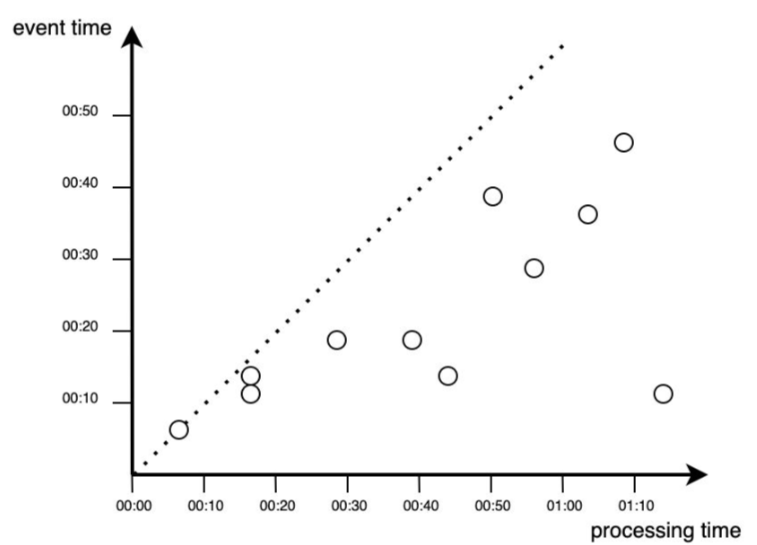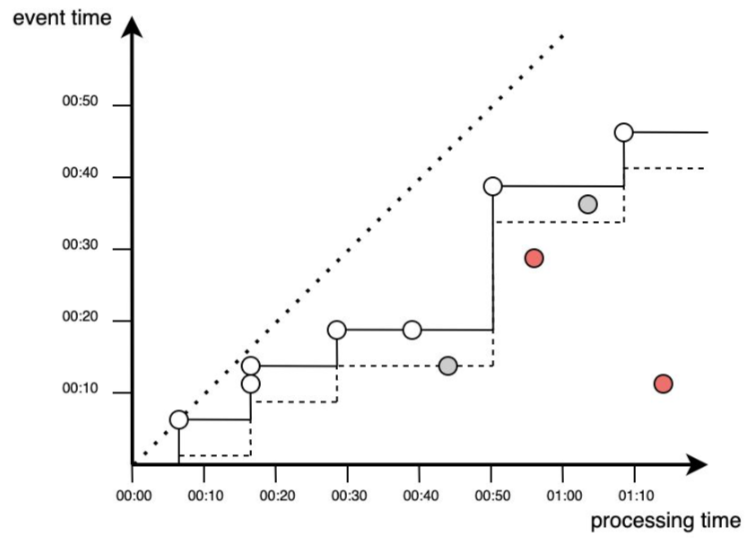Lecture 3 - Microservices architecture
Time in real-time data analysis
In the case of batch processing, we process historical data and the start time of the processing process has nothing to do with the time of occurrence of the analyzed events.
For streaming data, we have two time concepts:
event time- time in which the event happened.processing time- time during which the system processes the event.
In an ideal situation:

In fact, data processing always takes place with a certain delay, which is represented by the points appearing below the function for the ideal situation (below the diagonal).

In stream processing applications, the differences between the time of the occurrence of an event and its processing prove to be important. The most common causes of delay are data transmission over the network or lack of communication between the device and the network. A simple example is driving a car through a tunnel and tracking the position via a GPS application.
Of course, you can count the number of such missed events and trigger an alarm if there are too many such rejects.
The second (probably more often) used method is the use of the so-called correction watermarking.
The real-time event processing process can be represented as a step function, represented in the figure: 
As can be seen, not all events contribute to the analysis and processing. The implementation of the processing process along with additional time for the occurrence of events (watermarking) can be presented as a process covering all events above the dashed line. The extra time allowed for additional events to be processed, but there may still be points that will not be taken into account. 
The situations presented in the graphs clearly indicate why the concept of time is an important factor and requires precise definition already at the level of defining business needs. Timestamping data (events) is a difficult task.
time-windows
Tumbling window is a fixed-length window. Its characteristic feature is that each event belongs to only one window.

Sliding window includes all events occurring in a certain length among themselves.

disjoint window has a fixed length, but allows one window to overlap another. Typically used to smooth data. 
Microservices architecture
The concept of microservices is essential to understand when working on architectures. Although there are other ways to architecture software projects, microservices are famous for a good reason. They help teams be flexible and effective and help to keep software loose and structured.
The idea behind microservices is in the name: of software is represented as many small services that operate individually. When looking at the overall architecture, each of the microservices is inside a small black box with clearly defined inputs and outputs.
An often-chosen solution is to use Application Programming Interfaces ( API) to allow different microservices to communicate
Communication through API
A central component in microservice architectures is the use of APIs. An API is a part that allows you to connect two microservices. APIs are much like websites. Like a website, the server sends You the code that represents the website. Your internet browser then interprets this code and shows you a web page.
Let’s take a business case with the ML model as a service. Let’s assume you work for a company that sells apartments in Boston. We want to increase our sales and offer better quality services to our customers with a new mobile application which can be used even by 1 000 000 people simultaneously. We can realize this by serving a prediction of house value when the user requests for pricing over the web.
Serving a Model
- Training a good ML model is ONLY the first part: You do need to make your model available to your end-users You do this by either providing access to the model on your server.
- When serving ML Model You need: a model, an interpreter, input data.
- Important Metrics:
- Latency,
- Cost,
- Throughput (number of requests served per unit time)
Sharing data between two or more systems has always been a fundamental requirement of software development – DevOps vs MLOps.
When you call an API, the API will receive your request. The request triggers your code to be run on the server and generates a response sent back to you. If something goes wrong, you may not receive any reply or receive an error code as an HTTP status code.
Client-Server: Client (system A) requests to a URL hosted by system B, which returns a response. It’s identical to how a web browser works. A browser requests for a specific URL. The request is routed to a web server that returns an HTML (text) page.
Stateless: The client request should contain all the information necessary to respond.
You can call APIs with a lot of different tools. Sometimes, you can even use your web browser. Otherwise, tools such as CURL do the job on the command line. You can use tools such as Postman for calling APIs with the user interface.
All communication is covered in fixed rules and practices, which are called the HTTP protocol.
Request
- An Endpoint URL a domain, port, path, query string - http://mydomain:8000/getapi?&val1=43&val2=3
- The HTTP methods - GET, POST
- HTTP headers contain authentication information, cookies metadata - Content-Type: application/json, text … Accept: application/json, Authorization: Basic abase64string, Tokens etc
- Request body
The most common format for interaction between services is the JavaScript Object Notation format. it is a data type that very strongly resembles the dictionary format in Python - key-value object.
{
"RAD": 1,
"PTRATIO": 15.3, "INDUS": 2.31, "B": 396.9,
"ZN": 18,
"DIS": 4.09, "CRIM": 0.00632, "RM": 6.575, "AGE": 65.2, "CHAS": 0, "NOX": 0.538, "TAX": 296, "LSTAT": 4.98
}Response
- The response payload is defined in the response header:
200 OK
Content-Encoding: gzip
Content-Type: text/html; charset=utf-8
Date: Mon, 18 Jul 2016 16:06:00 GMT Server: Apache
Path=/;Header example: “Content-Type” => “application/json; charset=utf-8”, “Server” => “Genie/Julia/1.8.5
Body example:
{":input":{"RAD":1,"PTRATIO":15.3,"INDUS":2.31,.....}}, {":prediction":[29.919737211857683]}- HTTP status code: • 200 OK is used for successful requests, • 40X Access Denied • 50X Internal server error
REST API
The Representational State Transfer (REST) API works just like other APIs, but it follows a certain set of style rules that make it reconizable as a REST API: - Client-server architecture - Statelessnes - Cacheability - Layered system - Uniform Interface